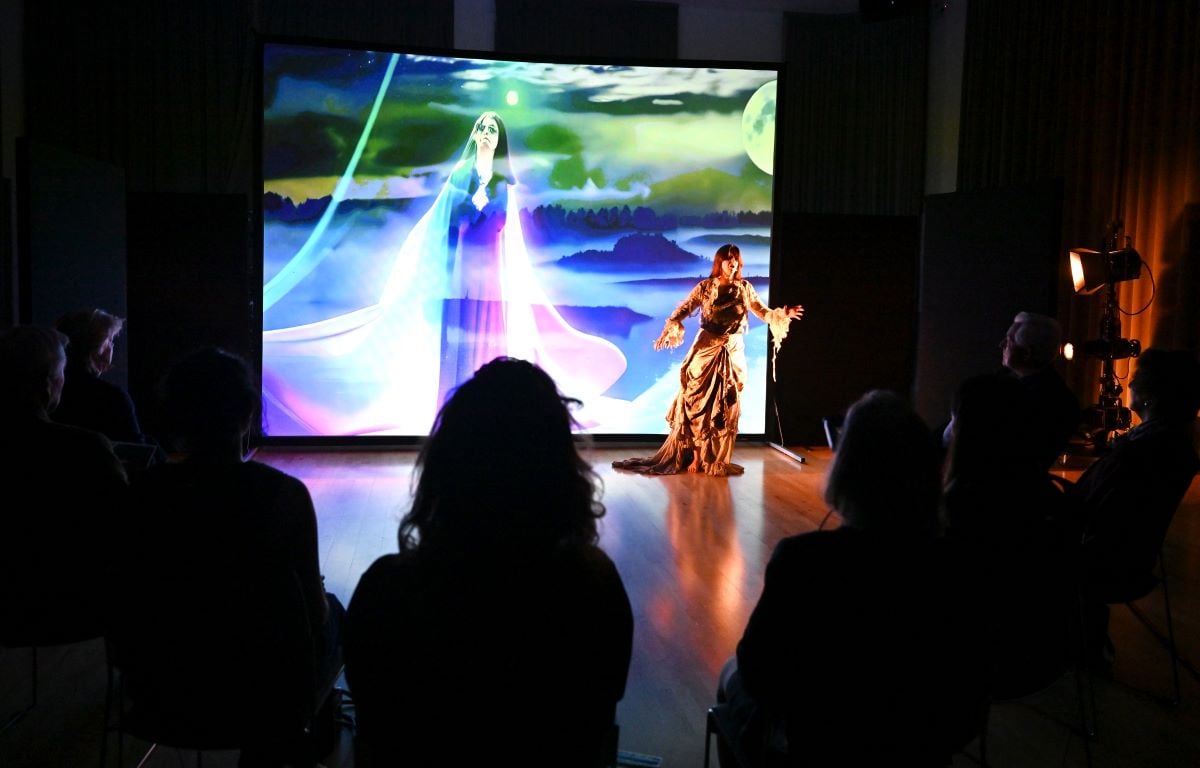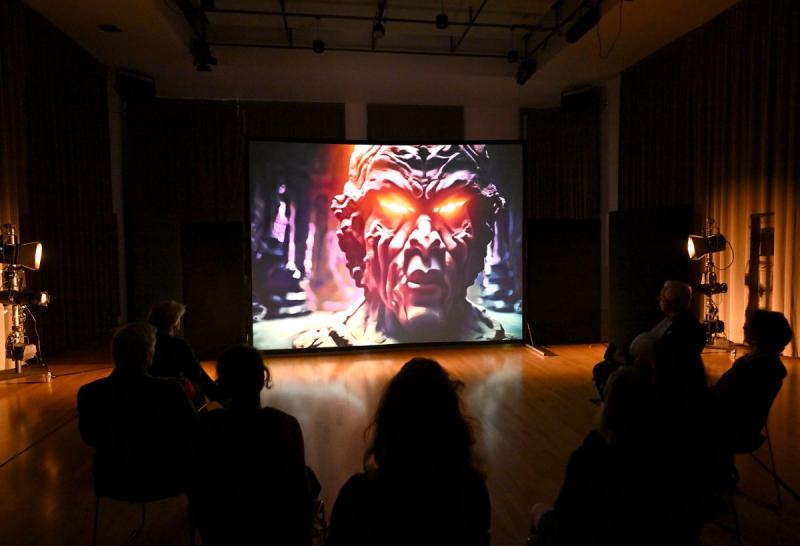
A staging of OpeRAVE: ARia on the 10th anniversary of Milton Court, Guildhall School of Music & Drama
Photo: Mark Allen
AI: Opera in a contemporary format
A recent project at Guildhall School of Music & Drama explored the intersection of traditional opera with evolving creative technologies, as visual artist Dan Shorten explains.
OpeRAVE: ARia was a project which combined advances in creative AI with traditional digital design and production processes to experiment with operatic content in a contemporary format. It culminated in a performance featuring a live soprano singing amid AI-generated projections.
As the singer’s aria gradually decayed the music morphed into woozy electronic sounds which resolved into a thumping, bass-heavy dance track. Audiences viewed the performance in three different ways: through AR glasses with dynamic visual elements inhabiting the space between audience and performer; by wearing haptic vests that converted the audio into vibrations so they could feel the music; or they simply experienced the performance un-augmented.
The project came about from a group of us – me, composer Toby Young and DJ Laurie Carrol – considering how we could make opera more accessible and relatable to modern audiences by creating a very different type of opera. It wasn’t an attempt to persuade existing opera audiences to embrace this hybrid. Rather, we used performance technologies and musical hybridity as mechanisms to bridge the gap between artforms and cross-pollinate audiences.
How can creative practice incorporate AI?
As a creative team, we are interested in how existing creative practices can incorporate new and evolving AI tools and techniques to probe traditional and classical forms in ways that feel fresh and challenging.
We questioned how these tools could help imagine a future in which opera and other traditional stage-based art forms could continue to evolve beyond the stage. AI offered a way for us as a group of digital artists from different disciplines to ideate quickly, to expedite our collaborative conversations and test ideas extremely efficiently.
In an era when technology seamlessly intertwines with art, and questions about authenticity, authorship and the role of the human in creativity abound, it’s important to include technological innovations in the creative processes. Especially ones that scare us, threaten existing systems and rules, or force us to ask new, deep and challenging questions.
As an artist, I feel obliged to investigate the posthuman concept rather than simply deny its value. I believe art should respond to it, challenge it and, where appropriate, embrace it. It is part of our lives, so it should be part of our art.
 OpeRAVE: ARia performed at Milton Court. Photo:Mark Allen
OpeRAVE: ARia performed at Milton Court. Photo:Mark Allen
A digital transformation
Technology for technology’s sake is dull and vapid. Rather than relying on it to invigorate art, and our lives, I am more interested in focusing on what art in the era of ubiquitous technology is or can be.
Can anyone now generate an image from a few words? Yes. Does that make them an artist? No. But can a group of artists utilise the tools meaningfully? I think so and, in time, this will progress into a powerful and beautiful practice.
The growth of personal computing triggered a digital transformation that has permeated our creative practices since the 1980s, evolving from niche, through specialist, into mainstream – now creating legitimate art. The latest technological advancements will follow a similar pattern.
The implications of AI for arts education are profound. Its darker side brings issues of plagiarism, cheating and false authorship. Perhaps even more dangerously, the degradation of the creative process or devaluing of creative outputs.
A period of exponential change
Advocates for technology – myself included – argue these are temporary consequences that can be overcome and that are outweighed by the greater good these tools promise. We are in a period of adjustment to rapid exponential change. It will take time to adjust, to become comfortable and to master and celebrate this new creative landscape.
Guildhall is a world-renowned conservatoire and we strive for excellence in technique. We strive to master our tools – be that an instrument, a voice, a body, or any other aspect of performance or stagecraft. In conservatoires like ours, AI can be a tool for good. But we must first master it. To do that we engage and play with it. We must experiment and learn. We must make mistakes and of course, we must practise.
AI can be invaluable for students and practitioners alike, offering new perspectives in performance, analysis, learning and, most importantly, creative expression. As AI continues to evolve, its potential in arts education and performance will grow, offering new ways to explore creativity and expression.
AI is not just a tool – it a collaborator
ARia exemplified how conservatoires can lead in integrating cutting-edge technology into traditional art forms, paving the way for a new era of expression in the stagecraft creative processes. It was a playful probe into how relatively simple technology can be used to complement and accompany classical stage-based arts.
It is a small step towards a future where technology is not just a tool, but a collaborator in the creative process. And when viewing technology, and AI in particular, in this upgraded role we have to remember that, like all partners in a collaborative process, AI is nothing by itself.
It is in the coming together of different people, different ideas and different processes that creativity thrives. Performance in not created in a vacuum, it is multidisciplinary, multifaceted and collaborative. And AI brings a new and interesting voice to the conversation.
Dan Shorten is a visual artist and Creative Director at Guildhall Live Events.
![]() gsmd.ac.uk/
gsmd.ac.uk/
![]() @guildhallschool
@guildhallschool
Join the Discussion
You must be logged in to post a comment.